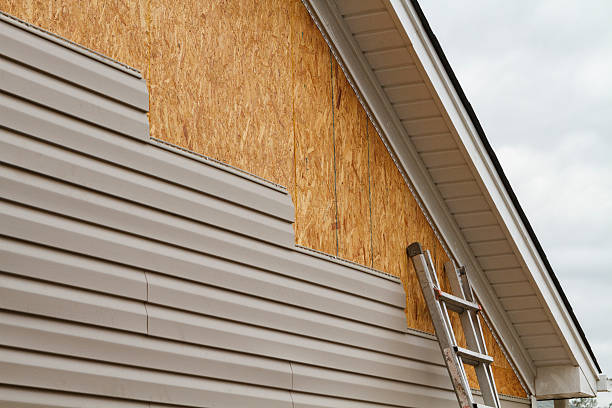Siding: The Unsung Hero of Your Home's Exterior

Here’s the deal: quality siding installed properly doesn’t just make your house look good; it’s your home’s armor, climate control partner, and one of the most impactful investments you can make in your property’s longevity and value.
Why Quality Siding Matters More Than You Think
Siding isn’t just about curb appeal (though that matters too). Let’s break down why this exterior component deserves serious consideration:
Protection Against the Elements
Blocks wind-driven rain from penetrating your walls
Creates a barrier against snow, ice, and humidity
Shields your home from damaging UV rays
Defends against insect intrusion and wildlife
Prevents mold and rot in your wall cavity
When siding fails at these jobs, the damage often goes unnoticed until it’s extensive and expensive. I’ve removed seemingly intact siding only to find thousands of dollars in structural damage lurking beneath.
Energy Efficiency Impact
Properly installed siding with good insulation can reduce energy costs by 20-30%
Poor siding installation creates thermal bridges that leak heating/cooling
Modern insulated siding options add R-value directly to your walls
Quality siding prevents air infiltration that bypasses your insulation
Value and Curb Appeal
Most homeowners don’t realize how much their siding affects their energy bills:
Properly installed siding with good insulation can reduce energy costs by 20-30%
Poor siding installation creates thermal bridges that leak heating/cooling
Modern insulated siding options add R-value directly to your walls
Quality siding prevents air infiltration that bypasses your insulation
With energy costs rising, the efficiency of your siding becomes more important yearly. The initial investment in better siding often pays for itself through accumulated energy savings.
Value and Curb Appeal
New siding typically returns 70-80% of its cost in increased home value
Homes with attractive, well-maintained siding sell faster than comparable properties
Siding replacement ranks among the top exterior improvements for ROI
The right siding choice can dramatically change your home's architectural character
Whether you’re planning to stay put or sell soon, siding delivers tangible value that few other exterior upgrades can match.
Siding Materials: Finding Your Perfect Match
The siding market has evolved dramatically in recent years, with new materials and technologies offering improved performance and aesthetics. Let’s examine your main options:
Vinyl Siding: Popular for Good Reasons
Vinyl remains the most widely installed siding material in America, accounting for approximately 30% of the market:
Pros:
- Most affordable option ($5-12 per square foot installed)
- Virtually maintenance-free (no painting required)
- Wide range of colors and profiles
- Won't rot, warp, or attract insects
- Modern options include insulated and impact-resistant varieties
- Typical lifespan of 20-40 years depending on quality
Cons:
- Can crack or break under impact
- Colors may fade over time, especially darker shades
- Lower-end products can look "plastic-y"
- Not biodegradable when eventually replaced
- Limited repair options (usually requires section replacement)
Vinyl has come a long way from the cheap-looking panels of the 1970s. Premium vinyl siding now believably mimics wood grain and offers impressive durability, making it a solid choice for budget-conscious homeowners who still want good performance.
Fiber Cement: The Professional's Choice
James Hardie and other manufacturers revolutionized the siding industry with fiber cement products:
Pros:
- Exceptional durability (30-50+ year lifespan)
- Outstanding weather and impact resistance
- Non-combustible and highly fire resistant
- Factory finishing with 15-year color warranties
- Authentic wood-look texture without the maintenance
- Resistant to insects, rot, and water damage
Cons:
- Higher cost than vinyl ($10-15 per square foot installed)
- Heavier material requiring more labor for installation
- Less DIY-friendly due to weight and cutting requirements
- Requires repainting eventually (typically 10-15 years)
- More complex installation with specialized techniques
As a siding installer who has worked with virtually every material available, I find myself recommending fiber cement more than any other option for clients who want the best balance of appearance, performance, and longevity.
Engineered Wood: Natural Look with Modern Performance
Products like LP SmartSide have created a compelling middle ground in the siding market:
Pros:
- Natural wood appearance with enhanced durability
- Lighter and easier to work with than fiber cement
- Better impact resistance than traditional wood
- Treated to resist fungal decay and insect damage
- More affordable than natural wood ($7-12 per square foot installed)
- Typically comes with 30-50 year limited warranties
Cons:
- Requires regular maintenance including painting every 5-7 years
- Less established long-term track record than other options
- More susceptible to moisture issues than fiber cement
- Not entirely immune to rot or insect damage over time
- Installation quality critical to performance
Engineered wood has gained significant market share by offering a compelling middle ground between traditional wood’s appearance and modern materials’ performance. It works particularly well for homeowners seeking a genuine wood aesthetic with more reasonable maintenance requirements.
Natural Wood: Classic Beauty with Higher Maintenance
Traditional wood siding continues to appeal to some homeowners despite maintenance requirements:
Pros:
- Unmatched natural beauty and character
- Biodegradable and environmentally friendly
- Can last 100+ years with proper care
- Easily repaired section by section
- Superior performance in very dry climates
- Available in numerous profiles (clapboard, shiplap, board and batten, etc.)
Cons:
- Significant ongoing maintenance (painting/staining every 3-5 years)
- Susceptible to rot, insects, and moisture damage
- Higher cost than many alternatives ($9-16 per square foot installed)
- Less energy efficient without additional insulation
- Requires expert installation for proper performance
While I admire the beauty of natural wood, I typically only recommend it for specific architectural styles where authenticity is paramount, or for homeowners who genuinely enjoy the maintenance routine.
Metal Siding: Durable Modern Alternative
Steel and aluminum siding offer unique benefits for certain applications:
Pros:
- Exceptionally long-lasting (50+ years)
- Fire resistant and impervious to insects
- Modern designs that move beyond the "mobile home" stigma
- Low maintenance requirements
- Recyclable at end of life
- Excellent at shedding water and snow
Cons:
- Higher cost for quality options ($8-14 per square foot installed)
- Can dent from impacts (hail, fallen branches, etc.)
- Limited style options compared to other materials
- Potential for noise during rain or hail
- Improper installation can lead to moisture issues behind panels
Metal siding works particularly well in modern architectural styles or in areas with extreme weather conditions. The standing seam and corrugated profiles have become increasingly popular for contemporary homes.
Siding Installation: Why the Details Make All the Difference
The quality of your siding installation matters as much as or more than the material itself. Here’s why proper installation is critical:
Moisture Management: The Hidden Champion
House wrap or weather-resistant barrier must be correctly lapped and sealed
Flashing must be properly integrated around windows, doors, and other penetrations
J-channels and trim pieces need correct installation to direct water away from walls
Proper spacing allows for expansion/contraction without creating entry points for water
Drainage planes behind the siding allow any trapped moisture to escape
I’ve torn off plenty of siding that looked fine from the outside only to find extensive water damage because these moisture management details were ignored during the original installation.
Insulation Integration Affects Performance
How your siding integrates with your home’s insulation system dramatically impacts energy efficiency:
Siding installation is an ideal time to add exterior insulation
Foam backer boards in some siding types minimize thermal bridging
Proper sealing at joints and penetrations prevents air leakage
Continuous insulation options can significantly boost R-value
Corner details and trim areas are common thermal weak points that need attention
A properly insulated siding job can reduce energy costs by 20-30% compared to older, poorly installed alternatives.
Expansion and Contraction Accommodation
Vinyl needs proper spacing at all termination points
Fiber cement requires specific gapping at butt joints
Fastener placement must account for natural movement
Corner treatments must allow for differential movement
Trim and accessory pieces need proper installation to allow movement without leaking
Failing to accommodate this natural movement leads to buckling, cracking, or popped fasteners that compromise both appearance and performance.
Signs It's Time to Replace Your Siding
Your home will tell you when siding replacement should be on your radar:
Visible Damage Can't Be Ignored
Cracks, gaps, or holes in siding panels
Warped, buckled, or sagging sections
Loose or missing pieces
Bubbling or blistering on the surface
Visible rot or deterioration at seams and edges
Hidden Problems That Signal Trouble
Not all siding problems announce themselves loudly:
Unusually high energy bills that keep creeping up
Interior wall damage or peeling wallpaper/paint
Mold or mildew inside your home, especially on exterior walls
Dry rot in wall framing (often detected during window replacement)
Fading color beyond normal weathering
Excessive caulking needed to seal gaps
These subtler signs often indicate that your siding is no longer providing the protection your home needs.
When Repair vs. Replacement Makes Sense
Not every siding issue requires a complete replacement:
Consider repair when:
- Damage is limited to a specific area (impact damage, small section deterioration)
- The siding is relatively new and matching materials are available
- The underlying wall system remains in good condition
- You plan to replace the siding within the next 2-3 years anyway
Replacement makes more sense when:
- Damage is widespread or systemic
- The siding is near the end of its expected lifespan
- The material is discontinued or impossible to match
- You want to improve energy efficiency or update appearance
- There's evidence of underlying structural issues
A professional assessment can help determine which approach makes the most sense for your specific situation.
The Roof Panther Siding Installation Process
At Roof Panther, we’ve refined our siding installation process through hundreds of successful projects:
Detailed Consultation and Planning
We assess your current siding condition and any underlying issues
We discuss your aesthetic preferences, budget considerations, and performance priorities
We present material options with samples you can see and touch
We provide detailed estimates with clear scope definitions
We develop a project timeline that works with your schedule
Professional Installation by Experienced Teams
Our installation crews follow proven procedures:
Careful removal of existing siding with attention to the underlying structure
Repair of any damaged sheathing or framing
Proper installation of moisture management systems
Precise cutting and fitting of siding materials
Attention to critical details around windows, doors, and architectural features
Thorough cleanup throughout the process
We don’t use day laborers or subcontract to the lowest bidder, our installers are experienced professionals who take pride in their craft.
Final Inspection and Quality Assurance
We inspect all aspects of the installation for quality and adherence to manufacturer specifications
We verify proper operation of all windows and doors
We ensure all debris and materials have been removed from your property
We walk through the project with you to address any questions or concerns
We provide maintenance information and warranty documentation
This quality assurance process confirms that your new siding meets our high standards and your expectations.
Siding Maintenance: Protecting Your Investment
Different siding materials have different maintenance needs:

Vinyl Siding Maintenance
- Annual washing with mild soap and water
- Inspection of caulking around windows and penetrations
- Check for loose or damaged pieces after storms
- Avoid power washing at high pressure, which can force water behind panels

Fiber Cement Maintenance
- Wash annually with mild cleaner
- Touch up any damaged paint or caulking promptly
- Maintain proper clearance between siding and ground level
- Repaint as needed (typically every 10-15 years depending on exposure)

Engineered Wood Maintenance
- Inspect regularly for signs of moisture problems
- Maintain paint coat in good condition (repaint every 5-7 years)
- Keep vegetation trimmed away from siding
- Address any damage or peeling paint promptly to prevent water intrusion

Traditional Wood Maintenance
- Check for peeling paint, cracks, or damage twice yearly
- Repaint or restain every 3-5 years depending on exposure
- Keep wood at least 6" above soil level
- Replace any damaged boards promptly
Ready to Transform Your Home's Exterior?
At Roof Panther, we bring our extensive experience with all types of siding to every project. Our team’s attention to detail, commitment to quality, and focus on customer satisfaction have made us the trusted choice for siding installation and repair throughout Champaign County.
Whether you’re looking to replace deteriorating siding, upgrade to a more energy-efficient option, or simply refresh your home’s appearance, we’re ready to help you navigate the options and deliver a result that exceeds your expectations.
Ready to explore how new siding could transform your home? Contact us for a free consultation, and let’s discuss how we can help protect and beautify your biggest investment for years to come.
Our Credentials

Licensed
In Illinois (#104.018415) and growing

Bonded
For your peace of mind

Insured
With high limits

Guaranteed
With a workmanship warranty
Contact Us! (Please provide your contact information below.)
We Look Forward To Working With You!
Roof Panther
903 N High Cross Rd. Urbana, IL 61802
By Appointment Only
Phone
(217) 530-8570
roofpanther@gmail.com

